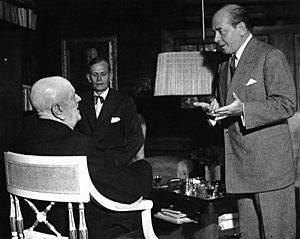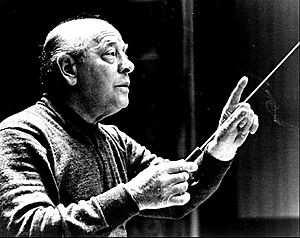Eugene Ormandy facts for kids
Eugene Ormandy (born Jenő Blau; November 18, 1899 – March 12, 1985) was a famous Hungarian-born American conductor and violinist. He is best known for leading the Philadelphia Orchestra as its music director for many years. His time with the orchestra lasted 44 years, which is one of the longest for any conductor with an American orchestra.
Ormandy made many recordings with the Philadelphia Orchestra. He also conducted other orchestras in Europe. He earned three gold records and two Grammy Awards. People knew him as a very skilled musician who helped orchestras sound amazing.
Contents
Early Life and Musical Beginnings
Ormandy was born in Budapest, which was then part of Austria-Hungary. His birth name was Jenő Blau. His parents were Benjamin Blau, a dentist and violinist, and Rozália Berger.
Eugene showed his musical talent very early. He was so good at the violin that he entered the Royal National Hungarian Academy of Music when he was only five years old. Just two years later, he began studying with a famous teacher named Jenő Hubay. By the age of 14, he had already earned a master's degree.
After playing as the lead violinist for the Blüthner Orchestra in Berlin, he also performed as a solo artist on tours. When he was 17, he became a professor of violin.
Between 1922 and 1925, Jenő Blau changed his name to "Eugene Ormandy." "Eugene" is the English version of "Jenő." The reason for the last name "Ormandy" is not fully known. His father also changed his last name to "Ormándi" in 1937, before moving to the United States.
Arthur Judson, a very powerful manager in American classical music, first heard Ormandy conduct. It was for a dance show at Carnegie Hall. Judson later said, "I came to see a dancer and instead heard a conductor." This meeting was very important for Ormandy's career.
A Long and Successful Career
Because of Arthur Judson, Ormandy got a chance to fill in for the famous conductor Arturo Toscanini with the Philadelphia Orchestra in 1931. This led to him becoming the music director of the Minneapolis Symphony Orchestra. He held this job from 1931 to 1936.
During his time in Minneapolis, he became well-known across the U.S. through his recordings. These included the first recordings of Kodály's Háry János suite and Schoenberg's Verklärte Nacht.
In 1936, he returned to Philadelphia. For two years, he shared the conducting role with Leopold Stokowski. In 1938, he became the orchestra's only music director. He kept this position for 42 years, until 1980. After that, he became the orchestra's conductor laureate, which means he was still honored and sometimes conducted.
Ormandy took the Philadelphia Orchestra on many tours both in the U.S. and around the world. He also conducted as a guest with other orchestras in Europe, Australia, South America, and East Asia.
The "Philadelphia Sound"
Ormandy built on the rich and beautiful "Philadelphia Sound" that his predecessor, Stokowski, had created. He made it even more polished and precise. However, some music critics thought his style was too focused on beauty and not deep enough. For example, Toscanini once joked that Ormandy was "an ideal conductor of Johann Strauss."
But many musicians and listeners loved his work. Donald Peck, a flutist with the Chicago Symphony Orchestra, said that when Ormandy conducted Beethoven's Ninth Symphony, it was the greatest he had ever heard.
Conductor Kenneth Woods praised Ormandy, saying that his Philadelphia Orchestra was a strong rival to Karajan's Berlin for its beautiful sound. He also noted that Ormandy's conducting technique was "classical and classy."
Ormandy was known for his "technicolored approach," meaning he brought a vibrant sound to the music. He often focused on music from the late Romantic period and early 20th century. These pieces, by composers like Debussy, Ravel, Richard Strauss, and Tchaikovsky, really showed off the orchestra's lush sound.

While he conducted less new music than Stokowski, he still supported modern composers. He led the first performances of important works such as Rachmaninoff's Symphonic Dances, which was dedicated to him. He also premiered Bartók's Piano Concerto No.3 and Britten's Diversions for Piano Left Hand and Orchestra. He also introduced music by American composers like Samuel Barber and William Schuman.
Music critic Harold C. Schonberg summarized Ormandy's career by saying he was a "perfect workman and a sensitive interpreter." He created a special place for himself in the world of classical music.
In 1980, at the age of 80, Ormandy stepped down as chief conductor of the Philadelphia Orchestra. However, he continued to appear as its conductor laureate. His very last concert with his Philadelphia colleagues was at Carnegie Hall on January 10, 1984. His time as chief conductor and then laureate was the longest continuous relationship between a conductor and a major American orchestra.
Eugene Ormandy passed away from pneumonia at his home in Philadelphia, Pennsylvania, on March 12, 1985. He was 85 years old.
Awards and Special Honors
Eugene Ormandy received many awards for his huge impact on American music and the arts in Philadelphia.
- On December 15, 1972, he received the University of Pennsylvania Glee Club Award of Merit.
- In 1976, Queen Elizabeth II made him an honorary Knight Commander of the Order of the British Empire (KBE).
- He also received Yale University's Sanford Medal.
- After Ormandy's death, the U.S. Congress and President Ronald Reagan declared November 18 "Eugene Ormandy Appreciation Day." A special ceremony was held on that day.
Personal Life and Marriages
On August 8, 1922, Ormandy married Stephanie Goldner (1896–1962). Stephanie, also known as "Steffy," was from Vienna. She came to New York in 1921 and became a harpist at the Capitol Theatre, where Ormandy was a violinist. For over ten years, she was the only woman harpist in the New York Philharmonic. They also performed together on WABC radio.
In 1946, the couple separated. Stephanie later filed for divorce, which was finalized on August 4, 1947.
On May 15, 1950, Ormandy married Margaret Frances Hiltsch (1909–1998) in Philadelphia. A statement from the Philadelphia Orchestra Association said they had been "family friends for many years." Margaret came to the United States from Vienna about 12 years before their marriage and became an American citizen. During World War II, she became a licensed pilot and served in the U.S. Navy.
Eugene and Margaret remained married until his death in 1985.
Recordings and Achievements
Ormandy's first digital recording was of Béla Bartók's Concerto for Orchestra for RCA Red Seal in 1979.
His recording career started with the Minneapolis Symphony for RCA Victor in 1934. He continued to record with RCA Victor after joining the Philadelphia Orchestra in 1938. In 1944, Ormandy and the Philadelphia Orchestra began a 23-year partnership with Columbia Records. In 1968, they returned to RCA Victor and recorded for that label until 1981.
His recordings of Saint-Saëns's Symphony No. 3, "Organ'" were highly praised. Fanfare Magazine called his 1974 RCA Red Seal recording with organist Virgil Fox the best ever. The Telarc recording of the symphony with Michael Murray from 1980 is also very well-regarded.
Under Ormandy's leadership, the Philadelphia Orchestra earned three gold records and won two Grammy Awards.
Film Appearance
- Night Song (1948)
See also
 In Spanish: Eugene Ormandy para niños
In Spanish: Eugene Ormandy para niños


